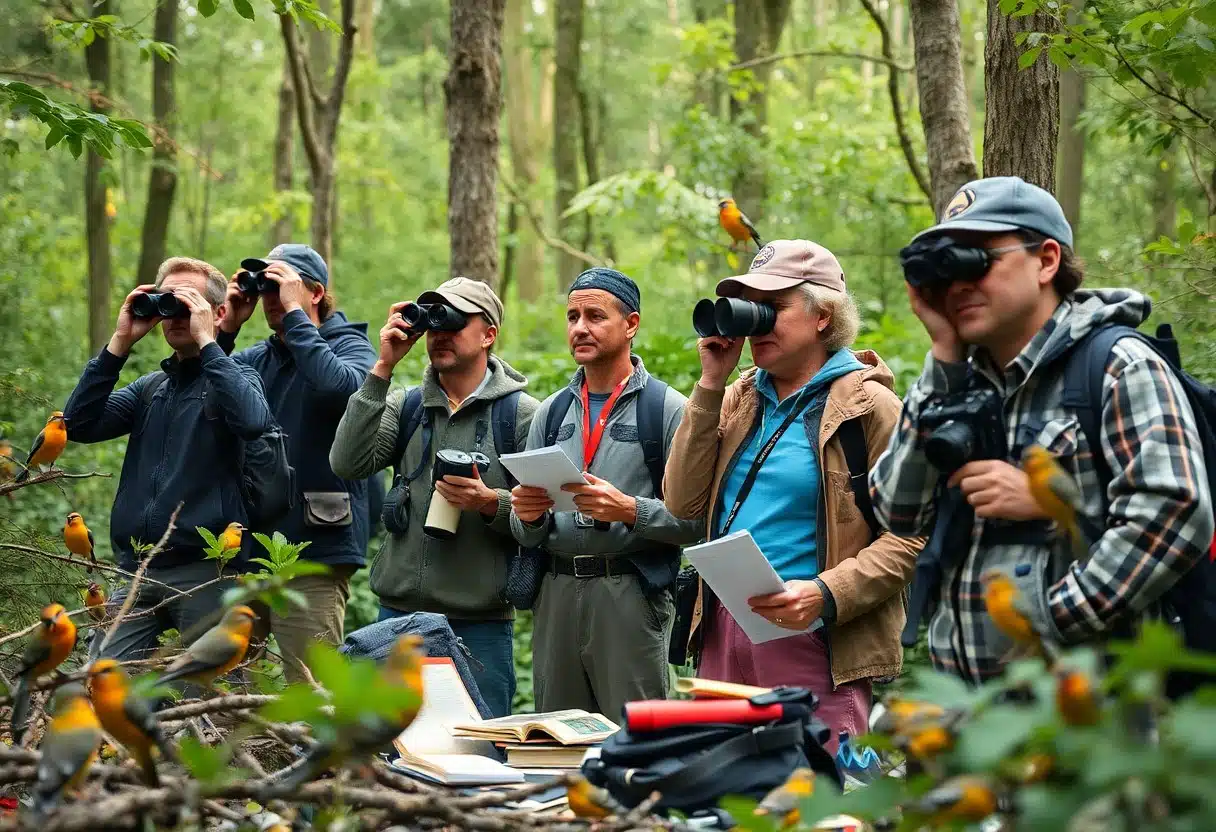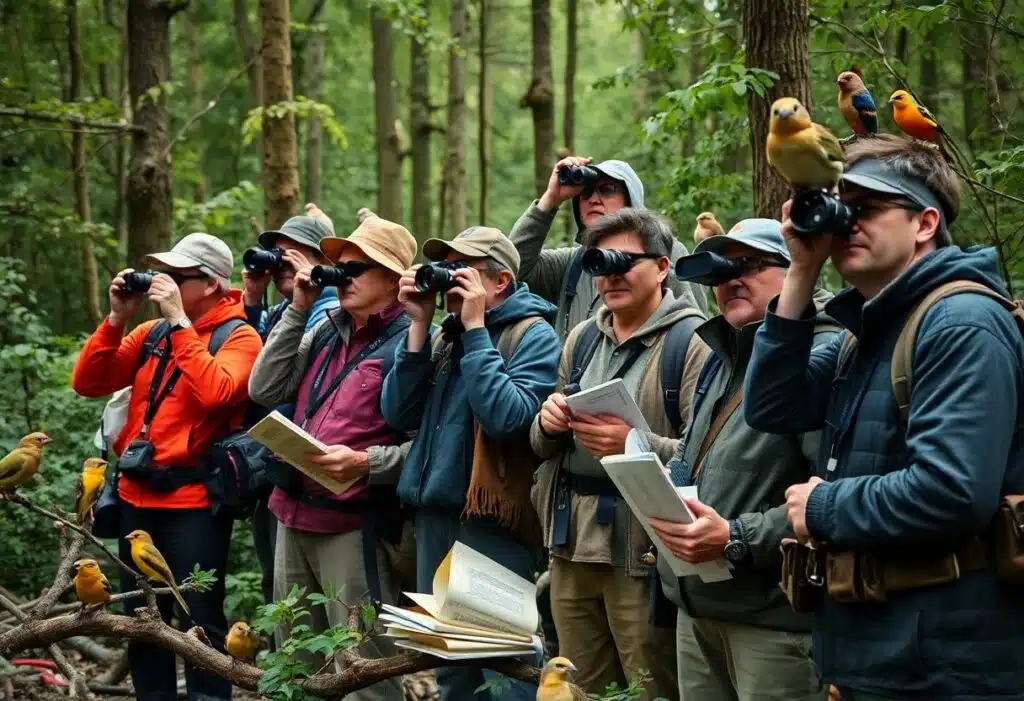Group Bird Watching Tactics: Essential Tips to Birding Like an Expert
Many bird watchers find that birding with a group enhances the experience dramatically. Whether you’re exploring local hotspots or venturing into new habitats, joining fellow birders can help you spot different species that you might miss on your own. With a combination of shared knowledge, enthusiasm, Many species of birds can be spotted in various habitats, including grassland. different sets of eyes, you’ll improve your bird identification skills and enjoy the adventure even more. In this guide, you’ll discover Imperative tips and strategies can make your start birding journey more rewarding. to birding like an expert while enjoying the beauty of the outdoors.
Key Takeaways:
- Join a Birding Group to share important tips and strategies for spotting birds of North America.
Working with fellow bird watchers can help you spot more birds. You can learn from their skills and share tips on identifying different species. Plus, two sets of eyes are always better than one! - Use a Field Guide
A field guide, like the Audubon Bird Guide, helps you learn about local birds. With illustrations, it’s easy to identify birds you see. They can show you details like field marks and calls that help with identification. - Bring the Right Gear
Having good bird watching binoculars and maybe a spotting scope makes a big difference. With the right tools, you can clearly see birds up close. Don’t forget bird feeders to attract birds to your finding spots!
Group bird watching is a great way to enjoy nature and learn more about the feathered friends around you.
When you team up with other birders, it’s not just about spotting birds. It’s about sharing experiences and learning together. Keep your eyes and ears open to every sound and movement. You never know what you might find! Birding is a fun adventure that can help you connect with nature. Plus, you can discover new birds in your area and learn more about the amazing habits of different species. Whether you are looking for sparrows in your backyard or hunting for hawks in a field, joining a group can enhance your enjoyment and knowledge of birding.

Understanding Group Bird Watching
The joy of bird watching often increases when shared with others. Group bird watching allows you to combine your skills and knowledge with fellow enthusiasts, making it easier to spot and identify diverse bird species. Engaging with experienced birders can also enhance your learning, as they provide tips on using binoculars effectively and identifying birds using a field guide. Group dynamics create a supportive environment where you can learn new birding techniques and enjoy the experience together.
Types of Group Bird Watching
- Birding Walks: Organized outings with a group to spot birds in a specific area.
- Bird Counts: Community events where participants tally the number of common birds.
- Workshops: Training sessions focused on bird identification and birding tips.
- Online Groups: Virtual forums where bird watchers share experiences and help each other.
- Field Trips: Planned excursions to hotspots with other bird watchers.
After joining any of these types of groups, you’ll likely find improved skills and increased enjoyment in your birding pursuits.
| Factor in the best birding tips to improve your overall birding experience. | Description |
| Experience Level | Different bird watchers have varying levels of skill and knowledge. |
| Group Size | Smaller groups may allow for more personal attention and easier identification. |
| Location | Some habitats are better suited for observing certain species. |
| Weather Conditions | Fair weather can lead to better bird activity and more sightings. |
| Time of Day | Mornings and late afternoons are prime times for bird watching. |
Factors Influencing Group Dynamics
The dynamics of your birding group can affect your experience significantly. Strong communication among members enhances cooperation when trying to spot birds. Having a mix of personalities can lead to a fun and engaging atmosphere, but conflicts may arise if not managed well. Also, the experience level within the group influences how information is shared about techniques and tools like binoculars or spotting scopes.
- Communication: Clear, open dialogue helps group members work effectively together.
- Experience: Varied skill levels can contribute to or complicate the group experience.
- Group Goals should include identifying as many species as possible during your outing.: Shared objectives can keep everyone focused and motivated.
- Roles: Defining roles, like leader or spotter, can streamline the birdwatching process.
- Decision Making: Group consensus is crucial for choosing viewing spots.
Perceiving how these factors play out in your group will guide your approach to better birdwatching Experiences in birding can be enriched by sharing knowledge from the Cornell Lab of Ornithology.
Group dynamics can change throughout your birding outings. Encouraging participation and recognition of each member’s contributions fosters a positive environment. Whether guiding discussions on identifying birds or adjusting your plans for the day, a strong group creates an enjoyable atmosphere for all. Note, birding should always be fun, and understanding each other’s backgrounds and interests can enhance your experience.
bird watchers
Essential Tips for Successful Birding
Assuming you want to elevate your birding skills, here are some important tips to enhance your birdwatching experience:
- Choose the right binoculars for clear viewing.
- Carry a good field guide to identify birds.
- Know the best birding spots in your area.
- Be mindful of the weather conditions.
- Be patient and enjoy the process of finding birds.
Perceiving the beauty and intricacies of birdwatching can lead to enjoyable encounters with wild birds.
Preparation and Planning
For a successful birding trip, you need to plan ahead. Research your destination and look for birding hotspots nearby. Consider the time of year and the most common bird species you might encounter. Also, prepare your bird feeders and set them up in your backyard to attract a variety of birds.
Communication and Coordination
If you’re birdwatching with a group, effective communication is vital. Ensure everyone knows the meeting time and location, and agree on how to share observations. This can maximize your chances of spotting important bird species.
Another key point in your birding outing is to maintain clear communication with your fellow birders. Discuss the bird sounds you hear and share your sightings, like knowing where to find that elusive woodpecker. You might also consider pairing up with someone familiar with local bird species. This way, you can gain insights on how to better identify birds and spot those nesting birds, making your experience richer and safer from any potential hazards.
Step-by-Step Guide to Group Bird Watching
Many bird watchers enjoy the experience of observing several bird species together. To make the most of your time with fellow birders, follow these simple steps. You will enhance your chances of spotting rare species and deepen your appreciation of birds of North America.
| Preparation | Gather your group, pick a birding location, and ensure everyone has the right equipment such as bird food and field guides. birding binoculars and a field guide like the Audubon bird guide. |
| Practice Good Communication | Establish a method for signaling and sharing information about bird sightings to keep your group engaged. |
| Assign Roles | Have members take on specific tasks, such as spotting or taking notes, to ensure everyone contributes. |
| Be Respectful of Nature | Follow local guidelines, keep noise to a minimum, and do not disturb birds or their habitats. |
Pre-Trip Checklist
To ensure a successful bird watching trip, prepare a checklist with vitals. Include your binoculars, a field guide to identify birds, snacks, water, and appropriate clothing for the weather. Consider bringing a notebook to record your sightings and the sounds you hear.
On-Site Strategies
To make the most of your bird watching, employ effective strategies while in the field. Begin by choosing a good spot where you can easily identify birds without disturbing them. Set up at a hotspot where birds are known to feed or nest.
It’s important to scan the area quietly and patiently, using your naked eye and binoculars to spot birds moving through the foliage. Listen for bird sounds, as they can guide you to nearby species. Stay still and blend into your surroundings; this way, you won’t scare the birds away. Work together as a group, sharing findings and observations to enrich the experience for everyone. You will enjoy the sense of community while enhancing your birding skills.
Evaluating the Pros and Cons of Group Birding
All bird watchers should weigh the pros and cons of group birding. Below is a simple table summarizing what to expect when you join fellow birders.
| Pros | Cons |
|---|---|
| More sets of eyes to spot birds | Group dynamics can be distracting |
| Shared knowledge and tips | May limit personal birding style |
| Safety in numbers | Difficult to accommodate everyone’s pace |
| Opportunities for social interaction | Group noise can scare birds away |
| Access to popular birding hotspots | Potential for competition over bird sightings |
Advantages of Birding in Groups
There’s a lot to gain by birding with others. You’ll find that more eyes and ears increase your chances of spotting many bird species. Experienced bird watchers can guide you on identifying birds and provide helpful tips. They might share their binoculars or field guides, improving your skills as a birder.
Potential Challenges
Challenges can arise when birding in groups. You might find it hard to enjoy the experience fully if the group becomes loud or if members have differing interests. It’s important to find a balance that benefits everyone while considering the birds’ comfort.
Advantages of group birding include learning from others and having fun outdoors. Yet, be aware of challenges like possible distractions and competition. Ensure the group’s focus is on enjoying the birding experience without scaring the birds away. Being considerate by keeping noise down and staying attentive can enhance the overall birding adventure.
Advanced Group Bird Watching Techniques
Despite the challenges of birdwatching in a group, employing advanced techniques can elevate your experience and success. These strategies can enhance your understanding of birds and improve your chances of spotting them together.
- Coordinate Timing: Plan your outings during early mornings or late afternoons.
- Set Group Rules: Establish guidelines for movement and noise to avoid scaring birds.
- Use Sign Language: Develop clear signals for spotting birds without excessive noise.
- Assign Roles: Allocate tasks like binocular holder, note-taker, and stand observer.
- Engage in Discussions: Share observations and questions during your birding adventures.
| Technique | Description |
|---|---|
| Buddy System | Pair up with another birder to enhance spotting chances. |
| Field Guide Sharing | Bring various field guides for rich discussions on different species. |
| Record Observations | Take notes together using eBird to keep track of sightings. |
Utilizing Technology for Group Birding
Group bird watchers can maximize their experience through technology. Using apps like Merlin Bird ID can help you quickly identify birds you encounter. Sharing real-time data within your group via eBird enhances your chances of spotting rare species and keeps everyone engaged.
Enhancing Identification Skills Together
To improve your bird identification skills as a group, consider practicing together. By sharing knowledge and resources, you can learn more about the birds in your area. Offer each other tips on identifying field marks, songs, and habitat preferences.
It’s beneficial to use resources like the Sibley Guide to Birds and the Audubon Bird Guide to enhance your learning. Discuss different bird species you encounter, focusing on their unique features and behaviors. Take time to share experiences of spotting birds from your backyard to national parks. This collaborative approach helps you build a strong foundation in birding skills. Plus, it connects you with various types of birds, from sparrows to owls, enhancing your overall birding experience.

Safety Considerations in Group Birding
After gathering your group of fellow bird watchers, it’s vital to address safety. Always communicate clearly about your plans, stick together, and maintain awareness of your surroundings. Make sure to carry a field guide and utilize binoculars appropriately. Keep your group informed about any potential hazards, and don’t forget to have a first aid kit on hand, just in case. Your safety should be a top priority while enjoying the beauty of birds in the wild.
Navigating Risks in the Field
An effective birding experience often involves navigating various risks. You should be cautious of uneven terrain, weather changes, and local wildlife. Paying attention to your surroundings helps you avoid potential dangers, ensuring a smoother birding adventure.
Environmental Awareness and Respect
The key to responsible birding is being mindful of your environment. You should respect the natural habitats of the birds you’re observing. Avoid disturbing nests and ensure you leave no trace of your visit. Being aware of local ecosystems helps in protecting these birds and their homes, making future bird watching possible.
Respect the habitats of the birds you encounter; each species has unique needs. Adhere to local guidelines and regulations while birding. This includes understanding nesting seasons and the impact of human interference. Always use binoculars instead of attempting to get too close, as this can lead to stress for the birds. By observing local wildlife laws, you help maintain the delicate balance of nature while enjoying the thrill of spotting birds.
Group Bird Watching Tactics: Essential Tips to Birding Like an Expert
Upon reflecting, group bird watching can enhance your birding experience significantly. Being with fellow bird watchers allows you to share tips, identify birds more easily, and enjoy the adventure together. You can learn a lot about bird species, habitats, and bird watching tips from others. Joining local birding groups or events, like those hosted by the National Audubon Society, can introduce you to new friends and hotspots. Utilize resources like the Audubon bird guide and eBird to elevate your skills and knowledge while uncovering the beauty of birds around you.
FAQ
Q: What are some tips for bird watching in a group?
A: When bird watching in a group, communicate quietly, decide on a meeting point, and share your spotting scopes or binoculars. Respect each other’s space while observing birds.
Q: How can I find local birding groups to join?
A: You can look for birding groups on social media, check the website of the American Birding Association, or visit the National Audubon Society for local meet-ups and events.
Q: What’s the best way to identify birds when bird watching with others?
A: Use a field guide, like the Audubon bird guide or Sibley guide to birds, along with apps like Merlin Bird ID. Look for field marks and listen to their songs and calls together.
As a bird enthusiast with a passion for sharing the wonders of our feathered friends. As a writer and nature lover, I'm thrilled to connect with fellow bird buffs and inspire others to take flight into the fascinating world of birds. Let's wing it together!


